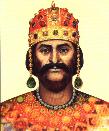
Many historians have written of the life and deeds of Ivan Assen II and unanimous by recognize him as one of the greatest statesmen of medieval Bulgaria. He would never use a sword where reason, humaneness and patience would do, for he would not have Bulgarian blood shed in vain.
The son of Tsar Assen I ascended the throne in 1218 after dethroning the mediocre Boril with the assistance of Russian and Kumanian troops. His lot was not an easy one: to restore the country, devastated by the incompetent rule of his forerunner. Ivan Assen II's ideas of state and governance far outshined those of neighboring rulers. His flexible diplomacy, eye for strategic marriages and good-will in relations with neighbors preserved the vital force of the nation.
The crusaders had settled in Constantinople, the once-mighty Byzantine empire was waning, divided into weak and constantly warring small countries, among which Nicea and Epirus were the most outstanding. Through negotiations and a daughter's marriage, Tsar Ivan Assen II regained the regions of Belgrade and Branichevo from the Hungarian king. A treaty with the despot of Epirus temporarily secured peace to the south-west. To achieve the same to the southeast, he had his daughter Elena betrothed to the Latin emperor.
Then the famous battle of Klokotnitsa took place, a culminating point in Bulgaria's medieval power. Ivan Assen II was not eager to fight, but the Despot of Epirus, the Byzantine noble Todor Comnenus, embarked on a campaign against Bulgaria, hoping to restore the once glorious empire. "He was a brazen and tactless man... who would easily violate his oath and the treaties with his neighbors," Georgius Acropolites, a Byzantine notable, wrote about Comnenus.
He had been bound by a treaty and through the marriage of one of Ivan Assen's daughters to his brother to keep the peace. When Comnenus breached that treaty, dishonesty and honor clashed at Klokotnitsa, near today's Haskovo. According to the ruthless law of the Middle Ages Todor Comnenus claimed that might made right. To Ivan Assen II, punishing the perjurer was a matter not only of personal revenge but of averting the invader-posed threat to his people.
The battle was fought on 9 March 1230. When the Tsar raised his hand, a soldier carrying the violated treaty spit onto a spear led the troops forward. The Byzantines fought desperately but in the one-to-one combat the spirit and skill of Ivan Assen's soldiers, fighting for their native land, finally prevailed. "It was a sweeping victory. Todor was crushed... and taken prisoner. Also, a number of his relatives and notables with all their wealth were captured by the Bulgarians. Ivan Assen, however, was merciful and let most of the soldiers, the ordinary ones, go...," reads the Byzantine chronicler Georgius Acropolites's account of the event.
To celebrate his victory, the tsar completed the construction of the Church of the Forty Holy Martyrs in Turnovo. On one of its pillars one can still see the inscription in which Ivan Assen II proudly styled himself "tsar and lord of the Bulgarians".
His noble gesture of releasing the captured won Assen popularity among ordinary people of Byzantium so that when he followed the defeated Byzantine army, it was a bloodless campaign. Adrianople surrendered; Dimothiki Prilep, Seres and Pelagonia followed suit. The battle at Klokotnitsa and the subsequent campaign made Bulgaria the greatest power in the Balkans and Eastern Europe again. Bulgaria regained the lands that had been lost during Boril's brief and disastrous rule. Ivan Assen II succeeded in building up the internal unity of the vast state Its borders now reached the Adriatic, the Aegean and Black Sea, an apogee comparable only to Simeon's glory The new state incorporated all territories inhabited by Bulgarians. In The Life of Ilarion of Muglen it is said that "Ivan Assen II reigned over Bulgarians, Greek, Franks, Serbs and Albanians and over all towns from sea to sea..."
Ivan Assen II went on to call himself Tsar of the Bulgarians and Greeks, to put an end to the Hungarian raids and to thwart insidious plots against Bulgaria. He besieged Constantinople, entered into an alliance with the Latin Empire and Nicea and rejected a Union with the Pope. The Bulgarian Patriarchate was restored.
The rebellious nobles were finally subdued and their support was won by means of new lands and privileges. The persecution of the Bogomils ceased. Peace brought prosperity to the people, and trade with the Mediterranean region became brisk. The tsar minted coins and embarked on the construction of fortresses and monasteries. Royal deeds were issued for generous grants of land to the Church. The capital town of Turnovo was second only to Constantinople in the Balkans.
Numerous biographies and eulogies were written about Ivan Assen during his lifetime and after his death in 1241. Georgius Acropolites wrote: "He was marvelled and extolled by all, for he never drew a sword against his subjects, neither was he stained by the slaughter of Byzantines... Thus he was loved not only by the Bulgarians, but by the Byzantines and other peoples as well".

 My name is Radostina Georgieva, "Roddy".
My name is Radostina Georgieva, "Roddy".